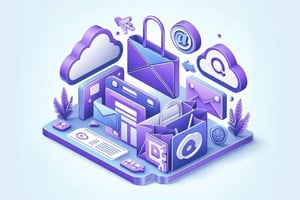In the constantly evolving landscape of ecommerce, where customer acquisition costs are soaring,...
Cashback VS Coupons: What is Better for Ecommerce Brands?

In the digital-first world of ecommerce, where direct-to-consumer (DTC) and consumer packaged goods (CPG) brands are constantly fighting for consumer attention and loyalty, the strategies being used in order to engage and retain customers should be well thought through.
Amidst a sea of promotional tactics, cashback and coupons are two dominant options, each with its unique appeal and potential impact on customer lifetime value (LTV). These incentives entice first-time buyers and also play a pivotal role in cultivating a loyal customer base, enhancing the LTV and enabling sustainable growth of ecommerce brands.
Understanding the nuances and implications in both cashback and coupon strategies are essential for brands looking to optimize their promotional efforts. There may be hidden costs to one of your brand's strategies or an opportunity cost being paid which has gone unnoticed.
This article dives into the intricacies of both through a detailed comparison and real world examples, offering insights into how they can influence consumer behavior, impact LTV, and ultimately determine which aligns best with the goals of DTC and CPG brands in the competitive ecommerce landscape.
Defining Cashback & Coupons in Ecommerce
Cashback: Cultivating Long-Term Engagement
What Are Cashback Programs? Cashback incentives reward customers with a portion of their spending back, either as credit for future purchases or direct cash rewards. This strategy is used to encourage ongoing loyalty by directly linking rewards to purchase activity.
Advantages for Ecommerce Brands -
Foster Repeat Purchases: By offering a monetary return on each transaction, cashback programs motivate customers to continue shopping with your brand, enhancing purchase frequency.
Increase Lifetime Value (LTV): The effect of repeated engagements driven by cashback rewards, contribute significantly to an increase in customer lifetime value.
Strengthens Brand Loyalty: Cashback programs create a positive feedback loop, where customers feel valued and appreciated, thus deepening their loyalty and attachment to the brand and returning for more purchases.
Coupons: Incentivizing Immediate Purchases
What Are Coupon Discounts? Coupons give instant discounts on purchases, either as a percentage reduction, a fixed amount off or access to exclusive deals. They serve as a useful tool for driving sales, clearing inventory and introducing new products, with the majority of the benefits taking place in the short term.
Advantages for Ecommerce Brands -
Drive Urgent Sales: The time-sensitive nature of coupons generates immediate spikes in sales, acting as a powerful tool for meeting short-term revenue goals.
Attract a Broad Customer Base: Whether targeting new customers (first time buyers) or re-engaging existing ones, coupons offer an incentive for consumers to choose your brand over competitors.
Offer Strategic Flexibility: Coupons can be tailored to achieve specific objectives, from promoting less popular products to rewarding customer loyalty, providing brands with a dynamic promotional instrument.
Cashback VS Coupons
In ecommerce, going with the right promotional strategy is essential for driving engagement and maximizing lifetime value (LTV). Cashback and coupon programs, while both effective, cater to different brand objectives and customer behaviors.
Here’s a deeper look into their advantages, challenges and contexts in which they excel.
Impact on Consumer Behavior -
Cashback: This strategy encourages a cycle of repeat purchases by rewarding customers after they buy, fostering a sense of accumulation and future gain. It’s particularly effective for promoting loyalty, as the rewards customers earn are typically used for subsequent purchases, ensuring continued engagement with the brand.
Coupons: Offering immediate discounts and savings makes coupons efficient tools for incentivizing trials, encouraging bulk purchases or pushing specific products. The instant gratification of coupons can significantly drive conversion rates, particularly in competitive markets where price sensitivity is high.
Impact on Customer Lifetime Value (LTV) -
Cashback: By incentivizing repeat business, cashback programs directly contribute to increasing LTV. Customers engaged in cashback schemes are likely to spend more over time, attracted by the prospect of earning rewards on each purchase. This repeated engagement builds a deeper brand connection, improving customer loyalty.
Coupons: While effective for boosting short-term sales, coupons may not always foster long-term loyalty unless integrated into a broader engagement strategy. They can, however, be instrumental in attracting new customers or reactivating lapsed customers, potentially increasing the customer base and offering opportunities to nurture these new relationships into long-term loyalty.
Brand Loyalty and Perception -
Cashback: Cashback programs are generally perceived as adding continuous and ongoing value to the customer’s shopping experience, enhancing a brand’s "customer-centric" approach. This perceived value can elevate the brand's status in the consumer's mind, making it more likely for them to choose it over competitors.
Coupons: Coupons need to be used carefully and not excessively to avoid any negative impact on brand perception. Over-reliance on coupons might lead customers relying on coupons to make purchases or associating the brand with discounts rather than value, quality or exclusivity, which undermines brand equity in the long run.
Flexibility and Strategic Application -
Cashback: Cashback is pretty straightforward and offers less flexibility in marketing creativity in comparison to coupons. Its strength lies in its simplicity and the clear value proposition it offers, making it a reliable tool for building long-term customer relationships.
Coupons: Coupons tend to offer a high degree of flexibility, allowing brands to tailor promotions to specific products, customer segments, or strategic goals. This adaptability makes coupons a versatile tool for addressing various objectives, from clearing old inventory to launching new products.
For personalized coupons ("JOHN15") sent to your customers in automated flows based off specific goals (ie, re-engagement or pushing a sale), take a look at LTV.ai. We run hyper-personalized & conversational email/sms marketing for leading ecommerce brands to drive repurchases, loyalty and increase owned channel sales by 10-25%.
Short-Term Gains vs Long-Term Engagement -
Cashback: Cashback is inherently designed for long-term engagement - it establishes a reward loop that customers are motivated to continue, enhancing their connection with the brand over time. This makes cashback a useful choice for brands focused on cultivating lasting customer relationships and maximizing LTV.
Coupons: With their immediate impact and scarcity / urgency creation, coupons well-suited for achieving short-term sales targets. They can effectively attract a wide audience quickly, making them ideal for promotional spikes, product launches or acting against competitive market actions. However, for long-term loyalty, they should be part of a broader strategy that also considers customer engagement beyond the transaction.
Real World Examples
Here are some real world examples of ecommerce brands effectively using coupons and cashback programs
Sephora Beauty Insider Program:

Sephora’s Beauty Insider program uses a points based cashback model, rewarding customers with points for every dollar spent. These points can later be redeemed for discounts on future purchases, essentially acting as cashback. This system encourages repeated engagement by directly linking spending with rewards, enhancing the customer's LTV by incentivizing continuous purchases.
Warby Parker’s First Purchase Coupons:
Warby Parker uses coupon codes to attract first-time buyers, offering discounts such as a percentage off or free shipping on the initial purchase. This immediate savings opportunity lowers the entry barrier for new customers, making it an attractive option for those on the fence about trying Warby Parker’s products, and sets the stage for future engagement.
Nike Membership:

Nike offers a membership program where customers accumulate points on purchases, which can be converted into discounts for future shopping. This direct approach to cashback fosters a loyalty loop, encouraging brand enthusiasts to keep coming back. By integrating these rewards with exclusive member-only products and events, Nike strengthens its brand loyalty and customer engagement.
Blue Nile’s Promotional Coupons:
Blue Nile, specializing in fine jewelry, leverages coupons to entice customers, offering periodic codes for free shipping or a discount on select purchases. Particularly effective around significant shopping periods like Valentine’s Day or Christmas, these coupons not only drive sales but also enhance customer satisfaction by providing value through savings on high-ticket items.
How Ministry of Supply use AI to only offer Coupons when needed
A leading menswear brand, Ministry of Supply, was having issues with their customers being overly dependent on discounts, despite detailed segmentation and triggers, which was hurting their margins.
To combat this, they tested out LTV.ai to see how the addition of Hyper-personalized AI email/sms outreach into their marketing stack would impact their full-price conversions, customer loyalty, customer satisfaction and LTV. The results were better than expected...
The Goal?
The overarching goal was to re-engage customers that hadn't purchased in 180+ days by offering little to no discounts and testing out different levels of discounts for different customer segments. Eg. If someone has purchased 3 years ago, offer them 30% off but if someone purchased 6 months ago, offer them 10% off.
These churned customers were incredibly valued individuals that had been lost but Ministry of Supply didn't want to temporarily slash their margins in order to get them back.
LTV.ai's Strategy?
LTV.ai sent a sequence of 5 text-based emails from a "brand ambassador" dedicated to these lapsed customers, mentioning variables like their physical location and previous feedback and offering personalized product recommendations based on their previous purchases.
These emails also featured dynamic coupon code usage, meaning customers only got coupon codes if they were proving incredibly difficult to re-engage. When coupons were offered, they were hyper-personalized ("AMY15" for 15% off) and varying levels of discounting was testing for different customer segments (some got 10% off, while others got 25% off).
LTV.ai's AI also held conversations with customers over email, to nurture the relationship and help guide them towards the next purchase that would be perfect for that one individual.
The Results?
LTV.ai's impact was impressive:
🟢 $0.91 revenue per unique lapsed customer
🟢 +9.93% conversion rate
🟢 11.59% of total brand revenue driven by LTV.ai
🟢 20x ROI
Apart from this, LTV.ai also:
🟣 Sent hyper-personalized text based emails, with personalized product recommendations, that customers loved
🟣 Held 100's of AI driven conversations over email to nurture customer purchases
🟣 Only offered coupon codes when necessary to maximize margins
🟣 Gathered tons of feedback directly from customers to stop future churn before it occurs
The Verdict -
In ecommerce, choosing between cashback and coupons depends on balancing short-term gains with long-term customer engagement. Sephora and Nike's cashback programs prove how rewarding repeat purchases can deepen loyalty and enhance customer lifetime value (LTV) over time. Meanwhile, Warby Parker and Blue Nile's use of coupons demonstrate the immediate impact of encouraging first-time purchases and meeting quick sales targets.
Ultimately, the most effective strategy for ecommerce brands involves a balance and blend of both, leveraging coupons for immediate engagement for converting newer customers, re-engaging lapsed customers and creating urgency around events and cashback for sustained, long-term loyalty. Think of coupons as a top off funnel, never to be overused and cashback as a mid - end of funnel.
This balanced approach allows brands to attract new customers while nurturing a loyal base, creating an ecosystem that boosts both immediate sales and long-term LTV.





